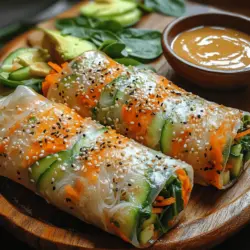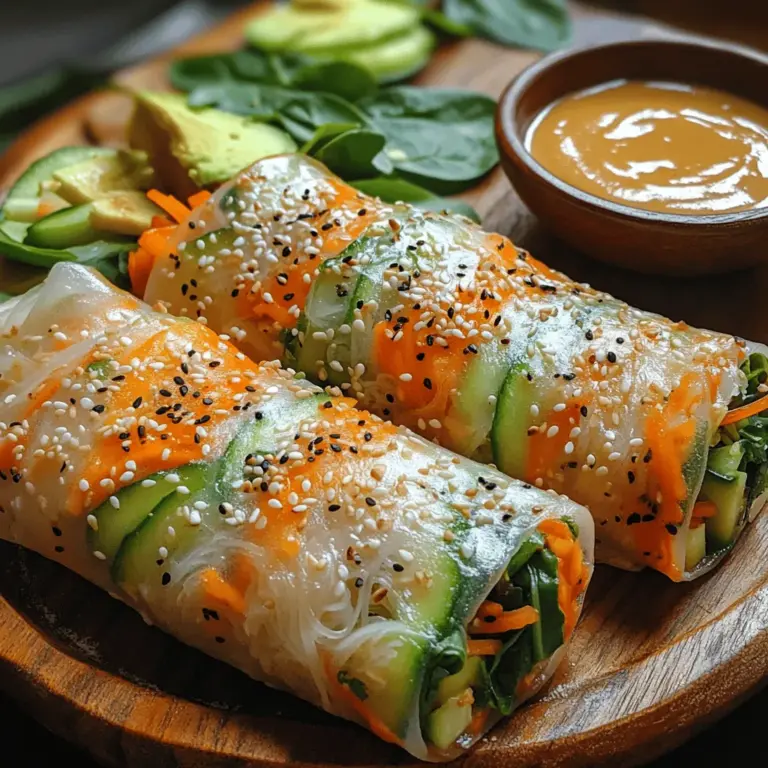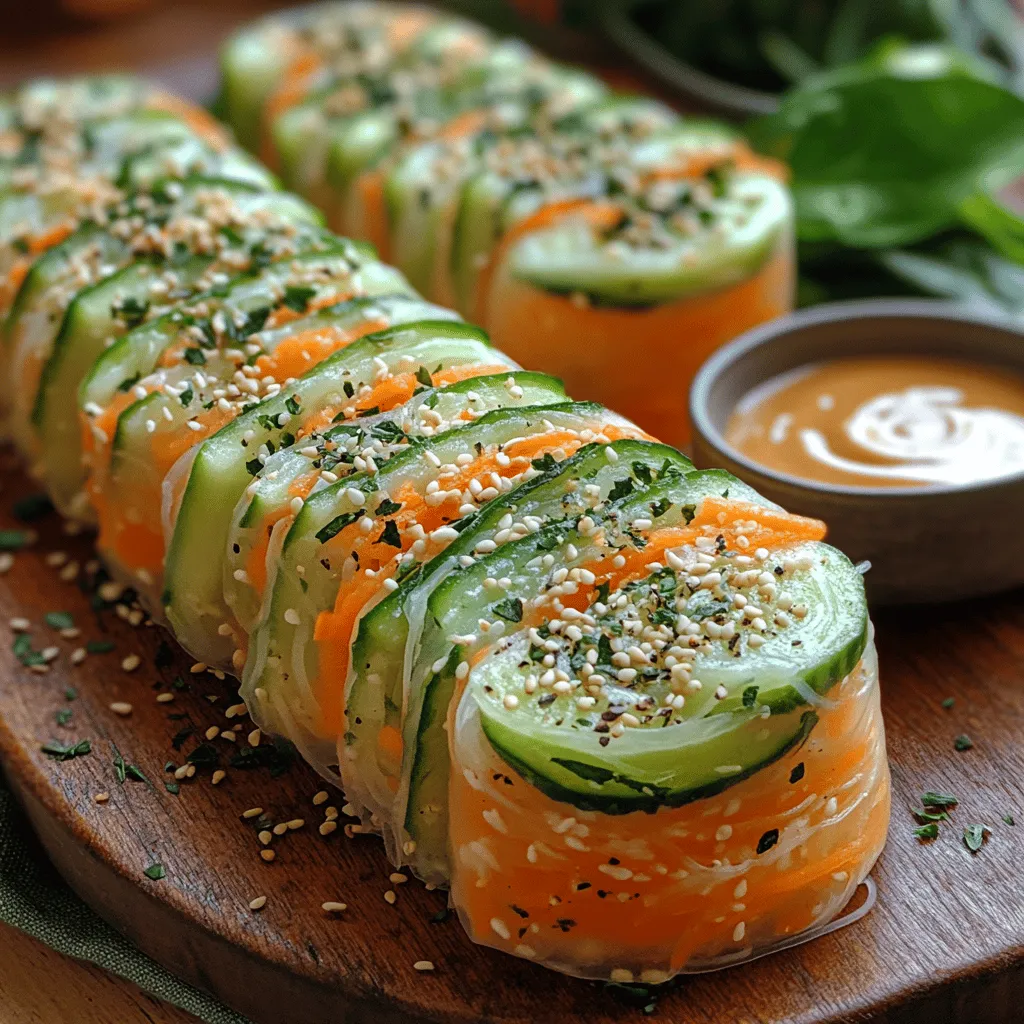Introduction
Thai cuisine is celebrated worldwide for its vibrant flavors, fresh ingredients, and the perfect balance of sweet, salty, and spicy elements. From aromatic curries to refreshing salads, the culinary tradition of Thailand offers a wealth of delicious options that can cater to all tastes and dietary preferences. Among these delightful dishes, Cold Thai Veggie Peanut Wraps stand out as a nutritious and refreshing choice, ideal for a variety of occasions.
These wraps are not only visually appealing but also packed with nutrients, making them an excellent option for health-conscious eaters. Whether you’re looking for a satisfying lunch, a quick snack, or a light dinner, these Cold Thai Veggie Peanut Wraps are versatile enough to fit any meal plan. They can easily be customized to suit different dietary needs, be it vegan, gluten-free, or simply a light meal option. The combination of fresh vegetables, a creamy peanut sauce, and the satisfying crunch of rice paper wrappers creates a delightful eating experience that is both nutritious and fulfilling.
In this article, we will guide you through the step-by-step process of making these wraps, from selecting the right ingredients to perfecting the peanut sauce. Get ready to learn how to prepare a dish that not only tantalizes the taste buds but also nourishes the body.
Understanding the Ingredients
Rice Paper Wrappers
At the heart of our Cold Thai Veggie Peanut Wraps are the rice paper wrappers. These translucent sheets are made from rice flour and water, making them a fantastic gluten-free option for anyone looking to avoid gluten in their diet. Rich in texture, they serve as a light and delicate base that holds the fresh ingredients together without overpowering the flavors of the fillings. Besides being gluten-free, rice paper wrappers are low in calories, which makes them an appealing choice for those watching their intake.
Vermicelli Noodles
Next, we have vermicelli noodles, which are often found in various Asian dishes. Made from rice, these thin noodles add a satisfying chewiness to the wraps while providing a source of carbohydrates for energy. They are incredibly versatile and can be used in numerous dishes, but in our Cold Thai Veggie Peanut Wraps, they serve to enhance the texture and add body to the filling. Cooking them is quick and easy, making them an efficient ingredient to incorporate into your meals.
Fresh Vegetables
The fresh vegetables are the stars of this recipe, contributing not only to the flavor but also to the nutritional profile of the wraps. Key ingredients include:
– Carrots: Packed with beta-carotene, which is great for eye health, carrots add a natural sweetness and crunch to the wraps.
– Cucumbers: Refreshing and hydrating, cucumbers are low in calories and high in water content, making them an ideal ingredient for a light dish.
– Bell Peppers: Available in various colors, bell peppers add a pop of color and a sweet crunch. They are rich in vitamins A and C, which are essential for maintaining a healthy immune system.
– Avocado: Creamy and nutrient-dense, avocado provides healthy fats that help keep you satiated. It also adds a smooth texture that complements the other ingredients.
– Leafy Greens: Greens such as lettuce or spinach add volume and a plethora of vitamins and minerals, making the wraps even more nutritious.
Incorporating a rainbow of fresh vegetables not only enhances the visual appeal but also maximizes the health benefits of your wraps.
Peanut Sauce
No Cold Thai Veggie Peanut Wrap would be complete without a delicious peanut sauce, which serves as the essential flavor component of the dish. The sauce is typically made from peanut butter, which is rich in protein and healthy fats, adding a creamy and indulgent element to the wraps. For those with nut allergies, alternative nut butters such as sunflower seed butter or tahini can be used to achieve a similar flavor and consistency.
A well-balanced peanut sauce incorporates sweet, salty, and tangy flavors. Common ingredients include soy sauce (or tamari for a gluten-free version), lime juice, honey (or maple syrup for a vegan option), and chili paste for a bit of heat. The key is to find the right balance that suits your taste preferences.
Alternative Ingredients
This recipe is versatile enough to accommodate various dietary needs. For those following a gluten-free diet, tamari can be used instead of soy sauce. Similarly, if you are vegan, substituting honey with maple syrup ensures that the sauce remains plant-based. Feel free to experiment with your favorite flavors and ingredients to make this dish your own.
Preparing the Peanut Sauce
Creating a flavorful peanut sauce is a crucial step in making the Cold Thai Veggie Peanut Wraps. The sauce should ideally strike a balance between sweetness, saltiness, and acidity to elevate the overall flavor of the wraps. Here’s how to prepare a delicious peanut sauce:
1. Ingredients: Gather your main ingredients for the sauce, including creamy peanut butter, soy sauce or tamari, fresh lime juice, honey or maple syrup, and chili paste or sriracha for heat.
2. Mixing: In a bowl, combine the peanut butter with soy sauce, lime juice, and honey or maple syrup. Use a whisk or fork to blend until smooth.
3. Adjusting Consistency: If the sauce is too thick, add warm water a tablespoon at a time until you reach your desired consistency. The peanut sauce should be pourable but not too runny.
4. Taste Testing: Adjust the flavors to your liking. If you prefer more sweetness, add a bit more honey or maple syrup. For a saltier kick, incorporate additional soy sauce or tamari. If spice is what you seek, increase the amount of chili paste or sriracha.
5. Variations: Feel free to customize the sauce further. For a nut-free version, substitute peanut butter with sunflower seed butter or tahini. You can also add grated ginger, minced garlic, or sesame oil to enhance the flavor profile.
By following these steps, you’ll create a peanut sauce that not only complements the fresh veggies but also brings the entire dish together with its rich, nutty flavor.
Vegetable Preparation
Once your peanut sauce is ready, it’s time to prepare the vegetables for the wraps. Proper preparation ensures that each bite is packed with flavor and texture. Here’s a step-by-step guide on how to prepare the vegetables:
1. Carrots: Start by peeling the carrots and then shredding them using a box grater or a food processor. Shredded carrots provide a delightful crunch and are easy to wrap.
2. Cucumbers: For the cucumbers, wash them thoroughly and slice them in half lengthwise. Remove the seeds with a spoon, then julienne the cucumber into thin strips. This technique allows for easier wrapping and a burst of freshness in each bite.
3. Bell Peppers: Choose bell peppers that are firm and vibrant in color. Slice them in half, remove the seeds and core, and then julienne into thin strips. You can mix and match different colored bell peppers for a visually stunning presentation.
4. Avocados: Halve the avocado and remove the pit. Scoop out the flesh and slice it into thin strips. Avocado adds creaminess to the wrap, enhancing both flavor and texture.
5. Leafy Greens: If using leafy greens like lettuce or spinach, rinse them under cold water and gently pat dry. You can choose to leave the leaves whole or tear them into smaller pieces, depending on your preference.
6. Freshness and Quality: Selecting high-quality, fresh vegetables is paramount. Opt for organic produce when possible, as this often ensures better flavor and nutritional value. Look for vibrant colors and avoid any wilted or bruised vegetables.
7. Customization: Finally, feel free to explore additional vegetable options that suit your taste. You can include bean sprouts for an added crunch, or substitute other vegetables based on seasonal availability.
By taking the time to prepare your vegetables thoughtfully, you’ll ensure that your Cold Thai Veggie Peanut Wraps are not only healthy but also visually appealing and delicious.
Mastering the Rice Paper Wrappers
Mastering the rice paper wrappers is a key technique in making these Cold Thai Veggie Peanut Wraps. The process can seem daunting at first, but with a little practice, you’ll be wrapping like a pro in no time. Here’s how to handle the rice paper wrappers effectively:
1. Soaking the Wrappers: Fill a shallow dish or a plate with warm water. One at a time, dip a rice paper wrapper into the warm water for about 10-15 seconds, or until it becomes pliable but not too soft. Be careful not to soak it for too long, as it can become too fragile to work with.
2. Laying the Wrapper: Once the wrapper is pliable, lay it flat on a clean, damp cutting board or a plate. This helps prevent sticking and makes it easier to roll.
3. Filling the Wrapper: Start layering your prepared vegetables in the center of the wrapper. Begin with a small amount of vermicelli noodles, followed by shredded carrots, julienned cucumbers, bell peppers, avocado slices, and a handful of leafy greens. Remember not to overfill; a little goes a long way.
4. Rolling Technique: To roll the wrap, fold the bottom edge of the wrapper over the filling, tucking it in gently. Then, fold in the sides and continue to roll tightly until you reach the top edge. Use a gentle touch to avoid tearing the wrapper.
5. Setting Aside: Place the completed wrap seam-side down on a plate. Repeat the process with the remaining wrappers and filling ingredients. If you find that the wrappers are sticking together, you can place a damp paper towel between them to keep them from adhering.
6. Serving Suggestions: Once all the wraps are assembled, serve them with the peanut sauce for dipping. You can also garnish with sesame seeds or chopped peanuts for added texture and flavor.
With these tips, you’ll become adept at handling rice paper wrappers, ensuring your Cold Thai Veggie Peanut Wraps are not only delicious but also beautifully presented.
Stay tuned for the next section of this article, where we will dive deeper into the serving suggestions and answer some common questions about these delightful wraps. Whether you’re a seasoned cook or a kitchen novice, this recipe will guide you in creating a fresh and zesty dish that is sure to impress.
Detailed Instructions for Softening Rice Paper Wrappers
Softening rice paper wrappers is a vital step in creating Fresh & Zesty Cold Thai Veggie Peanut Wraps. The key to achieving pliable wrappers without tearing lies in the technique used. Here’s a step-by-step approach:
1. Prepare Your Station: Clear a flat surface where you can assemble your wraps. Gather all your ingredients, including the softened rice paper wrappers, filling, and any tools you may need, like a pair of scissors for trimming.
2. Soak the Wrappers: Fill a large, shallow dish or a clean cutting board with warm water. Immerse the rice paper wrapper into the water for about 10 to 15 seconds. You want the wrapper to become soft but not overly mushy. If it starts to bubble or lose its shape, it has been in the water too long.
3. Check the Texture: Carefully lift the wrapper out of the water and gently touch it. It should still feel slightly firm; it will continue to soften as you work with it. If it seems too soft, set it aside for a moment before handling.
4. Avoid Tearing: When removing the wrapper from the water, gently shake off excess water before laying it flat on your surface. Avoid pulling too hard on the edges, as this can lead to tears.
Best Practices for Handling Delicate Wrappers
Handling rice paper wrappers requires a gentle touch. Keep these best practices in mind:
– Work Quickly: Once the rice paper is softened, work efficiently to assemble your wraps before they become too sticky or difficult to handle.
– Use a Damp Cloth: If you notice the wrappers starting to dry out while you are working, lightly cover them with a damp cloth to keep them moist.
– Avoid Overlapping: When stacking multiple wrappers, avoid overlapping them directly to prevent sticking. Instead, place them side by side, slightly spaced.
Tips for Laying Out the Wrappers
To optimize the rolling process, consider the following layout tips:
1. Positioning: Place the softened rice paper wrapper on a clean, flat surface. Position it so that one edge is closest to you. This allows for easier rolling.
2. Layering Ingredients: Start by laying down a small portion of your filling ingredients in a horizontal line across the center of the wrapper, leaving about two inches of space on the sides. This ensures that your rolls have enough room to be folded without spilling out.
3. Mind the Order: Place heavier ingredients, like the peanut sauce and denser vegetables, at the bottom and lighter ingredients, such as herbs and sprouts, on top. This order not only balances the wrap but also adds visual appeal.
Alternatives to Rice Paper
For those looking to switch things up or explore different textures and flavors, several alternatives to rice paper wrappers can be used:
– Lettuce Leaves: Crisp lettuce, such as butter or romaine, can be a fresh and crunchy alternative. They provide a low-carb option and are easy to roll.
– Nori Sheets: For a different flavor profile, nori (seaweed) sheets can be used. They add a unique taste and are often found in sushi.
– Whole Wheat Tortillas: For a heartier option, whole wheat tortillas offer a different texture and can be easier to work with for beginners.
Assembling the Wraps
Now that you have your rice paper wrappers prepared, let’s dive into assembling your wraps for maximum flavor and visual appeal.
1. Layering Technique: Start by placing your desired fillings in the center of each wrapper. Begin with a spoonful of peanut sauce, followed by a mix of julienned vegetables (carrots, bell peppers, cucumber), fresh herbs (basil, mint, cilantro), and any protein you may be using (tofu or tempeh).
2. Balance and Aesthetics: Aim for a colorful mix of ingredients to make your wraps visually appealing. The bright colors of the veggies, herbs, and sauces not only enhance the look but also contribute to the overall flavor profile.
3. Avoid Overfilling: It may be tempting to pack in as much filling as possible, but overfilling can lead to tearing. A good rule of thumb is to fill just enough so that the wrapper can be folded over without bursting.
4. Rolling the Wraps: To roll your wraps, start by folding the bottom edge of the wrapper over the filling. Tuck it in gently, then fold in the sides and continue rolling until you reach the top edge. It’s helpful to keep the roll snug but not too tight, allowing the ingredients to stay secure without causing the wrapper to tear.
Serving Suggestions
Making your wraps visually appealing and pairing them with appetizing sides can elevate your meal experience. Here are some presentation ideas and complementary dishes:
1. Presentation Ideas: To serve your wraps, consider cutting them in half diagonally to showcase the colorful fillings. Arrange them on a platter with fresh herbs or edible flowers for an attractive display.
2. Dipping Sauces: A variety of dipping sauces can enhance the flavor of your wraps. Traditional Thai peanut sauce works beautifully, but you can also offer a sweet chili sauce or a tangy soy-ginger dressing to cater to different tastes.
3. Complementary Side Dishes: Pair your wraps with light side dishes such as Thai-inspired salads made with fresh greens, mango, and a lime vinaigrette. A fruit platter featuring tropical fruits like pineapple, watermelon, and mango can also provide a refreshing balance to the meal.
4. Cultural Context: Cold Thai veggie wraps are reminiscent of traditional Thai dining practices, where fresh ingredients take center stage. They are often enjoyed as a light snack or appetizer, emphasizing the balance of flavors and textures that Thai cuisine is known for.
Nutritional Benefits
These wraps not only taste great but also offer a bounty of health benefits. Here’s a breakdown of the nutritional advantages of the ingredients used:
1. Macronutrient Balance: The combination of fresh vegetables, peanut butter, and optional protein sources like tofu ensures a balanced intake of carbohydrates, healthy fats, and proteins. This balance is essential for sustained energy throughout the day.
2. Vitamins and Minerals: The vegetables used in the wraps provide an array of vitamins and minerals. For instance, carrots are rich in beta-carotene (vitamin A), while bell peppers are high in vitamin C. Leafy greens contribute iron and calcium, enhancing the overall nutritional profile.
3. Dietary Considerations: These wraps can easily be tailored to meet dietary needs, being naturally gluten-free and vegan. For those with nut allergies, a sunflower seed butter or tahini can be used as a substitute for peanut butter.
Conclusion
Fresh & Zesty Cold Thai Veggie Peanut Wraps are not only a delicious dish but also a versatile one that fits seamlessly into a balanced diet. Their easy preparation allows for customization, making them ideal for anyone looking to explore new flavors or accommodate specific dietary preferences.
By embracing fresh ingredients and simple techniques, you can celebrate the essence of Thai cuisine right in your kitchen. Whether enjoyed as a light lunch, a vibrant appetizer, or a healthy snack, these wraps promise a delightful experience that emphasizes the joy of eating well. So gather your ingredients, follow these steps, and enjoy the burst of flavors in every bite.



